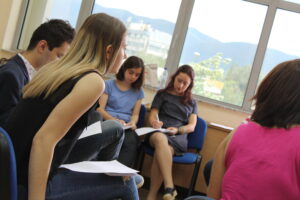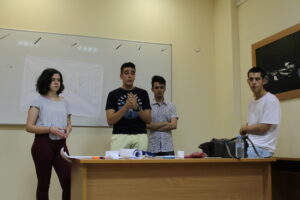On the morning of Thursday, June 29, Building Bridges participants started engaging in discussions of identity, human needs, and corresponding rights. Activities and workshops were successfully facilitated by Bridging Backgrounds Program Director Brendan Schultz, Coordinator Hristijan Zafirovski, and volunteer Elena Gagovska. The first activity “Who are I”, led by Brendan, asked participants to write down characteristics that define them such as class and temperament. The activity drew attention to the distinctions between external factors which individuals have no control over that influence their perception of themselves and their presentation to the world, such as ethnicity, and factors that individuals have a degree of control over, such as their work ethic and personal interests.

Other activities, however, took on a different, in a sense, more collective approach. Led by Elena, “Needs and Rights” was an activity that tied universal human needs to human rights, specifically social rights. Participants were asked to think about which needs — including basic, safety and family needs — were most important and the relevance of each human need has with various human rights. Almost unanimously, the participants felt that basic needs, such as food, water, and shelter were most important, and, thus, the rights to life, healthcare and social security held priority. At the end of the exercise, Elena explained American humanist psychologist Abraham Maslow’s Pyramid of Needs in which basic needs find themselves on the bottom, followed by safety, social relations, and esteem, ending with self-actualization. “You came to these conclusions on your own, which proves the intuitiveness of Maslow’s theory and its applicability to our understanding of social rights,” Elena said to the participants, pleased that the activity proved to be successful.
Moreover, “Where Do You Stand?”, facilitated by Elena and Hristijan, seemed to serve as an extension of “Needs and Rights”, urging participants to assess which human rights were the most important in their view. After being taught the distinction between political and civil rights and social and economic rights, the participants were given different statements that they could agree, disagree or be undecided/neutral about. For example, statements such as “The right to ‘rest and leisure’ is a luxury that only rich people can afford” or “Extreme social inequality is an infringement of basic rights” did not have a clear group majority and prompted heated debates. However, most of the group agreed with the statement “It’s more important to have a home, food and basic necessities than to be able to say what you like”, indicating that they valued the (economic) right to an adequate living standard more than the (political) right of freedom of speech.
Furthermore, “Fighters for Rights” was a particularly important activity which gave historical context to how some rights were won and how activism looks like outside of the realm of already established documents. Facilitated by Brendan and Elena, the participants compiled the biographies of six activists: Nelson Mandela, Evgenia Ginsberg, Martin Luther King Jr., Mahatma Gandhi, Daw Aung San Suu Kyi and Ngawang Sangdrol. Discussion arose of some of the techniques used by these activists, such as protests, peaceful demonstrations, and boycotts, as well as the role of oppressive political regimes and colonialism in the catalyzation of mass movements. All six of the activists that they learned about opposed oppressive policies and spent time in jail. However, their actions led to greater human rights gains. Perhaps the most important lesson that the participants would take away from this activity was that often activism means dissidence and personal sacrifice.

As opposed to the much more interactive workshops facilitated by Brendan, Hristijan, and Elena, Martin Miloshevski, a staff member of the National Youth Council of Macedonia, led Community Activism Training sessions that focused on concrete strategies for successful project developments. As the participants were expected to come up with community activism project ideas for which they are to receive funding, these types of workshops were essential for the realization of their visions. Martin explained the differences between small groups, forums, and public meetings, as well as the advantages and disadvantages for each. For example, forums are a great way for engaging people from different backgrounds; however, this could also mean that unwelcome and unuseful opinions could also get a platform. Additionally, Martin gave advice on how to conduct questionnaires and social media PR, providing very important tips on how to collect necessary data, as well as how to do outreach.

“Bridging Backgrounds is a wonderful opportunity for the young people of Macedonia. I had an outstanding opportunity to share my experience and work with a wonderful group of young people highly motivated and determined to become active citizens. I will closely follow the work of these young people and I am looking forward to contributing to the upcoming editions of the program,” Martin enthusiastically stated after the program’s end.
An important lesson that Martin delivered was about finding common ground between different interested parties. For example, if a conference is held about youth leaving Macedonia at a staggering rate, the organizers of that conference should keep the interested parties of that issue in mind. Politicians would want more veterinary medicine youth to stay so that the country could prosper, the business owners would not want potential workers to leave, young people would not want to only see their friends once a year when they visit for the holidays. Bridging Backgrounds as a conference, in a sense, follows this model by bringing interested parties to the same place. The Davis foundation’s interests are to support motivated youth, the organizers’ interests are teaching youth and providing the kind of education that was not available to them, the participants’ interest is to learn about human rights and to make connections with people who can help them in their goals to better their communities. Indeed, Bridging Backgrounds is a learning experience and a dynamic event for all involved.

